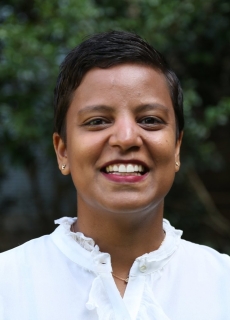UNSW social sciences researcher Dr Caroline Lenette shares insights into the research method that breaks down the barriers between refugees and academics.
A South Sudanese refugee takes photos of her car in a driveway and the empty back seats. According to refugee researcher Dr Caroline Lenette, the photo of the car is symbolic of the single mother’s independence, her achievements raising five children alone, renting a home, working full-time and studying at university. On the flipside, the photos of the empty seats convey her anxiety of seeing her children grow up, preparing to leave home, being independent and not needing her as much in their lives.
The UNSW School of Social Sciences senior lecturer and senior research associate at the Australian Human Rights Institute says this is a good example of the effectiveness of arts-based research. She describes the unique advantages of the method in the sensitive and complex area of refugee research in her book Arts-based methods in refugee research: creating sanctuary.
In arts-based research, people can use photos, digital storytelling, community music and video to explore issues of interest to them and from their perspective. Dr Lenette, who is also a member of the Faculty of Arts & Social Sciences Forced Migration Research Network, says the non-intrusive storytelling method reveals more meaningful research of the lived experience of asylum and migration than traditional methods of surveys and interviews. She says it can challenge what it means to be a refugee, make a life in a new country and seek sanctuary.
“What is often missed in more rigid ways of doing research is that there is an assumption that people from a refugee background are all the same and they experience things in the same ways,” she says.
“But we know that women, for example, have very different experiences to men for a diversity of reasons. Being able to offer methods that can uncover a specific aspect of their experiences are very important, because otherwise we get a very linear description of how people from refugee backgrounds adapt to new contexts.”

Dr Caroline Lenette. Image: supplied.
Dr Lenette gives an example. Often the male head of a refugee family goes to English language classes while the woman stays home to look after children.
“If there are no childcare services, women can never get to English language classes. The flow-on effect is that, without English language, it’s harder for them to get jobs, go to the doctor, access higher education or support their children. And then, what if they are divorced? There are stigmas attached to that. Or if they are widowed and raising children alone – and are still having to meet all the expectations in a new country?”
The researcher mainly works with South Sudanese, Iranian and Afghani refugees who have recently arrived in Australia. She says she gets excited when she sees photos that refugees were able to keep during flight – “which is quite rare” – but also the photographs they take in Australia.
“The photos are interesting in terms of what’s foreign, what’s new, what represents an opportunity, what represents exclusion,” she says. “Sometimes they are really difficult things to talk about … and wouldn’t come up when seeking that story. This is also a great way of sharing the research with broader audiences, because people do engage with photographs more than reading a report.”
Researchers began using arts-based research in the early ’90s and, in the last 20 years, in forced migration research. In her book, Dr Caroline Lenette’s shares insights from her use of the method over the past 10 years.
Using arts-based methods in refugee studies can offer sanctuary from the complications and stresses of everyday life, she says. It can counter damaging impacts of immigration and refugee policy, such as the indefinite detention of asylum seekers.
“Researchers have an added responsibility to make sure we do research well at a social level – being able to present some counter-narratives to what’s being disseminated in the media and in any political discourse. The debates around people from refugee backgrounds are pretty terrible, and arts-based research is contributing to changing the nature of this.”








